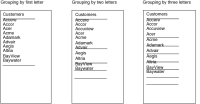Grouping string data by intervals
When grouping string data by interval, the interval you specify is a sequence of characters of a particular length. For example, if a customer group sorts customers by name, you can group customers by the first letter of their names, or the first two letters, or the first three letters, and so on.
Figure 9‑13 shows the results of grouping names by the first letter, the first two letters, and the first three letters. Lines separate the groups.
Figure 9‑13 Results of grouping string data by intervals
Group by the first letter to group names by letters of the alphabet. In a customer list, for example, you might want to group all customers whose names begin with A under the heading A, all customers whose names begin with B under the heading B, and so on.
Group by multiple letters to group items whose names contain special prefixes for classification or categorization. A computer parts vendor, for example, might use the prefix ME for all memory chips, CP for CPU boards, MO for monitors, and so on. In this case, creating a computer parts list that groups names by the first two letters lends itself to logical groupings by part type.
How to group string data by intervals
2 Set the Interval field in the group editor to Prefix.
3 Set Range to the number of characters by which to group.

